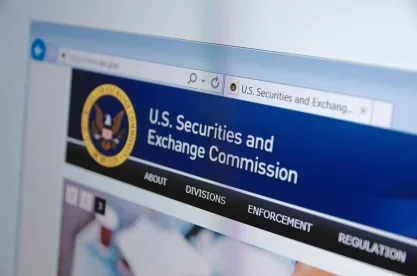The U.S. Securities and Exchange Commission (the “SEC”) has taken recent actions aimed toward expanding access to capital markets for smaller issuers and their investors. First, the SEC proposed a conditional exemption from broker registration for certain “finders” who assist certain issuers with raising capital in private markets. Second, the SEC adopted final rules that revise the exempt offering framework to reduce sources of regulatory friction and add clarity and efficiency to the private markets.
Small Business Finders
On October 7, the SEC voted to provide clarity on the regulatory status of “finders” who help small businesses raise capital. The Commissioners voted 3-2 in favor of a proposed finder exemption to the broker-dealer registration requirements of Section 15(a) of the Securities Exchange Act of 1934 (the “Exchange Act”). The proposal allows unregistered natural persons (finders) to engage in certain limited activities assisting issuers, oftentimes small businesses, in raising capital from accredited investors. The proposal would provide a non-exclusive safe harbor from the broker registration requirements where a finder’s involvement is limited to certain activities. Chairman Jay Clayton indicated that the proposed exemption would address challenges faced by small businesses as they attempt to raise capital, specifically with respect to businesses that lack access to abundant capital sources. He further indicated that the proposed exemption is aimed at addressing requests for regulatory clarity in the private placement market. Specifically, such exemption has the potential to increase access to capital and increase the number of participants in the private market.
A “broker” is defined under Section 3(a)(4) of the Exchange Act as “any person engaged in the business of effecting transaction in securities for the account of others.” The question of whether a person is a broker depends on the facts and circumstances. Historically, whether a finder must register as a broker was a fact-specific question based upon on a range of factors discussed in SEC no-action letters and various court decisions. These discussions identified certain activities as characteristic of broker status, which include, among other things:
-
actively soliciting or recruiting investors;
-
participating in negotiations between the issuer and the investor;
-
advising investors as to the merits of an investment or opining on its merits;
-
handling customer funds and securities;
-
having a history of selling securities of other issuers; and
-
receiving commissions, transaction-based compensation, or payment other than a salary for selling the investments.
Section 15(a) of the Exchange Act makes it unlawful for a broker-dealer to use the mails or other means of interstate commerce to “effect any transactions in, or to induce or attempt to induce the purchase or sale of, any security” unless registered with the SEC. Without an exception or exemption, brokers must register with the SEC, become members of the Financial Industry Regulatory Authority, Inc. (“FINRA”), and comply with ongoing regulatory requirements. These requirements can result in substantial costs. The SEC has not previously provided explicit relief to finders from registration, so market participants often have looked to SEC no-action letters to gauge the extent to which persons can engage in finder activities on behalf of issuers without registering.
Smaller companies oftentimes do not attract interest from venture capital or registered brokers, yet have capital needs that are too large to obtain from friends and family, which leaves a funding gap. Finders have the potential to fill this gap, but the regulatory uncertainty leads some finders to refrain from engaging in the market because it is unclear whether these activities would require registration under the Exchange Act.
The specifics of the proposed exemption include the establishment of two tiers of finders, labeled “Tier I” and “Tier II” finders. Each tier would be subject to conditions specific to the scope of the finders’ activities, and there would also be general conditions applicable to both tiers. Both Tier I and Tier II finders may only use the proposed exemption in limited circumstances. The exemption would be available only where:
-
Private Placement - the issuer is not required to file reports under Section 13 or Section 15(d) of the Exchange Act; and the issuer is seeking to conduct an offering in reliance upon an exemption from registration under the Securities Act;
-
Accredited Investors - the potential investor is, or the finder reasonably believes that the potential investor is, an “accredited investor” as defined in Rule 501 of Regulation D;
-
Written Agreement - the finder enters into a written agreement with the issuer that includes a description of the services provided and associated compensation;
-
Additional Prohibitions - the finder is not an associated person of a broker-dealer; at the time of the finder’s participation, the finder is not subject to “statutory disqualification,” as that term is defined in Section 3(a)(39) of the Exchange Act; and the finder does not engage in general solicitation.
Tier I Finders: The proposed exemption provides that a Tier I finder is one who meets the above conditions and whose activity is limited to providing the contact information of potential investors in connection with a single capital raising transaction by a single issuer in a 12 month period, and such Tier I finder does not contact a potential investor about the issuer.
Tier II Finders: Tier II finders would be allowed to solicit investors on behalf of an issuer in the following limited instances:
-
identifying, screening, and contacting potential investors;
-
distributing offering materials to potential investors;
-
discussing issuer information included in offering materials, which discussion shall not include advice as to the valuation or advisability of the investment; and
-
the arranging or participation in meetings with the issuer and investor.
Tier II finders must also satisfy the general condition discussed above. Since, under the proposed exemption, Tier II finders could engage in a larger number of activities than Tier I finders, a Tier II finder would be required to sufficiently disclose to potential investors the Tier II finders’ role and compensation at or prior to solicitation. Further, the Tier II finder must obtain from potential investors a written acknowledgement at or prior to the investment if the initial disclosure was provided orally. Certain activities, including assisting or providing financing for investment purchases, providing advice as to the valuation or financial advisability of investment, among other activities, would remain strictly within the purview of brokers.
The Comment period for the proposed rule ended November 12. Comments submitted to the SEC have been mixed, ranging from broad support to vehement opposition with concerns over investor protection. FINRA commented that they support the goals of the rule, but proposed alternative methods of achieving such goals. Generally, FINRA proposes that the SEC work with state securities regulators and FINRA to create separate rules for private placement broker-dealers tailored to such firms’ limited business models. The SEC will use these comments in determining whether to approve the rule and whether it should be amended before approval.
Exempt Offering Framework
On November 2, the SEC adopted final rules that the SEC believes harmonizes, simplifies, and improves the complex exempt offering framework. These amendments generally:
-
establish more clearly, in a broadly applicable rule, the ability of issuers to engage in contemporaneous or close-in-time offerings under independent exemptions;
-
increase the offering limits for Regulation A, Regulation CF, and Rule 504 offerings, and revise certain individual investment limits;
-
set clear and consistent rules governing certain offering communications, including permitting certain “test-the-waters” and “demo day” activities; and
- harmonize disclosure and eligibility requirements and bad actor disqualification provisions.
The amendments establish a new integration framework providing a general principle that looks to the particular facts and circumstances of two or more offerings, and focuses the analysis on whether the issuer can establish that each offering either complies with the registration requirements of the Securities Act, or that an exemption from registration is available for the particular offering. The SEC cautions that the rule may not be used in part of a plan or scheme to evade the registration requirements of the Securities Act.
Contemporaneous Offerings and Avoiding Integration
The SEC’s integration doctrine seeks to prevent issuers from avoiding registration requirements by artificially dividing a single offering into multiple offerings, applying exemptions for the multiple offerings that would be unavailable for the combined offering. Exemptions have different limitations and conditions like restrictions on general solicitation, so issuers can be out of compliance if the offerings are viewed as single, integrated offerings. New Rule 152(a) under the Securities Act of 1933 (the “Securities Act”) is based on a general principle of integration depending on the facts and circumstances of each offering. The new rule establishes four non-exclusive safe harbors from integration, which provide that:
-
if compliant with certain restrictions on general solicitation, any offering made more than 30 calendar days before the commencement of any other offering, or more than 30 calendar days after the termination or completion of any other offering, will not be integrated with such other offering(s);
-
offers and sales made in compliance with the SEC’s Rule 701 safe harbor exemption (pursuant to an employee benefit plan or agreement), or in compliance with the SEC’s Regulation S safe harbor exemption (pursuant to an offshore offering), will not be integrated with other offerings;
-
an offering for which a Securities Act registration statement has been filed will not be integrated if it is made subsequent to (a) a terminated or completed offering for which general solicitation is not permitted, (b) a terminated or completed offering for which general solicitation is permitted that was made only to qualified institutional buyers and institutional accredited investors, or (c) an offering for which general solicitation is permitted that terminated or was completed more than 30 calendar days prior to the commencement of the registered offering; and
-
offers and sales made in reliance on an exemption for which general solicitation is permitted will not be integrated if made subsequent to any terminated or completed offering.
“Test-The-Waters” and “Demo Day” Communications
Issuers in exempt offerings are subject to restrictions on communications to potential investors, which can impose compliance costs and limit issuers’ ability to reach investors. To address these issues, the amendments:
-
exclude certain “demo day” communications from being deemed general solicitation;
-
permit issuers to use generic solicitation of interest materials to “test-the-waters” before determining which exemption to use;
-
permit Regulation CF issuers to “test-the-waters” with potential investors before filing offering documents with the SEC; and
-
permit Regulation CF issuers to have oral communications with prospective investors after filing, provided that the communications comply with Rule 204.
Revising Offering Limits and Individual Investment Limits for Regulation A, Regulation Crowdfunding, and Rule 504 Offerings
Regulation A, Regulation CF, and Regulation D limit the amount of securities that can be offered, and Regulation CF also limits the amount each investor can invest. In an effort to broaden the use of these exemptions, the SEC has amended restrictions as follows:
-
For Tier 2 of Regulation A, the amendments:
-
raise the maximum offering amount from $50 million to $75 million in a 12-month period; and
-
raise the maximum offering amount for secondary sales from $15 million to $22.5 million.
-
-
For Rule 504 of Regulation D, the amendments:
-
raise the maximum offering amount of securities in a 12-month period from $5 million to $10 million.
-
-
For Regulation CF, the amendments:
-
raise the offering limit from $1.07 million to $5 million in a 12-month period;
-
remove the investment limits entirely for accredited investors;
-
revise the investment limit calculation for non-accredited investors; and
-
extend temporary relief until August 28, 2022, of certain financial statement review requirements for issuers offering $250,000 or less of securities.
-
Other Improvements to the Exempt Offering Framework
The amendments also:
-
change the financial information issuers must provide to non-accredited investors in Rule 506(b) private placements to align with the financial information that issuers must provide to investors in Regulation A offerings;
-
add a new item to the non-exclusive list of verification methods in Rule 506(c);
-
simplify certain requirements for Regulation A offerings and establish greater consistency between Regulation A and registered offerings; and
-
harmonize the bad actor disqualification provisions in Regulation D, Regulation A and Regulation Crowdfunding.






 />i
/>i
